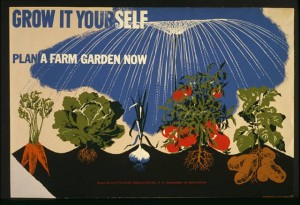
Poster for the U.S. Department of Agriculture promoting victory gardens, showing carrots, lettuce, corn, tomatoes, and potatoes growing.
In 2002, a call came to science to suggest patriotic topics for a Library-wide exhibit. I proposed the Victory Garden and was honored to put together an exhibit for members of the James Madison Council and Congress. I became an expert on the subject from this experience.
The concept of Victory Gardens was established in 1917, three years into World War I, when the National War Garden Commission initiated the Liberty or War Garden program. Even after the war ended in 1919, the War Garden Commission continued to promote these gardens with its Victory Garden campaign. Charles Lathrop Pack, president of the War Garden Commission, provides a great introduction to this campaign in his Victory Gardens Feed the Hungry: the Needs of Peace Demand the Increased Production of Food in America’s Victory Gardens .

Victory Gardens--for family and country. Sunday morning in many U.S. communities finds all the neighbors getting together for a good workout at the community Victory Garden.
When the United States entered World War II, American citizens aided the war effort in many different ways. Not only did individuals purchase bonds, conserve raw materials, ration and recycle, they also planted Victory Gardens. The Victory Gardens of World War II were started by a Government sponsored and directed movement spawned by the National Defense Garden Conference held in Washington, D.C. in December, 1941. Soon after, Victory Gardens were planted in every conceivable location across the country: farms, homes, schools, and suburban and city plots. In all, there were an estimated 20 million Victory Gardens in the United States that produced up to 40% of all food products consumed in America during World War II.
Chicago led the nation in urban food production from 1942-43, with an estimated 1,500 community gardens and more than 250,000 home gardens in its Victory Garden program. The city’s program was so successful that it was emulated across the country.
Today, cities across the United States are continuing this tradition with school and community garden programs. Chicago has an estimated 700 community gardens. It’s Peterson Garden Project is a shining example of a new generation of gardeners who “want to gain control of their food supply, grow organic produce, and make urban gardening the norm- not the exception.” It is Chicago’s largest organic community allotment vegetable garden, which happens to be part of an original WWII Victory Garden.
So why am I telling you all this?
On May 13th, ST&B is hosting a lecture “Chicago Victory Gardens: Yesterday and Tomorrow” with award winning gardener, blogger and founder of the Peterson Garden Project in Chicago, LaManda Joy. In an illustrated lecture, Joy will present the history and philosophy behind the Chicago Victory Gardens. She will also examine parallels with today’s gardening movement.
To inspire our audience, we will display materials from the Library’s collection on community, school, victory, and urban gardening, along with related guides on gardening, school gardens, and school gardening activities.
The event is free and open to the public; tickets are not required. We will also be filming the event, which will be posted on the Library’s webcast page.
Chicago Victory Gardens: Yesterday and Tomorrow
11:30 on Friday, May 13
Mary Pickford Theater on the third floor of the James Madison Building
101 Independence Ave. S.E., Washington DC
If you were not able to make it to the lecture, you can view the Chicago Victory Garden webcast.

July 21, 2011 at 5:37 pm
It’s amazing that 40% of the food consumed during WWII in the US was grown in home and community gardens.
The “local, organic, etc” food movement of today sometimes seems like such a drop in the bucket. Could something like the 40% figure be achieved today?
Our health would be greatly improved if we had an alternative to the products of large agribusiness concerns. This would be one way to fight back. See:
http://www.yourbodyofknowledge.com/social-political-economic-forces-conspire-against-your-health/